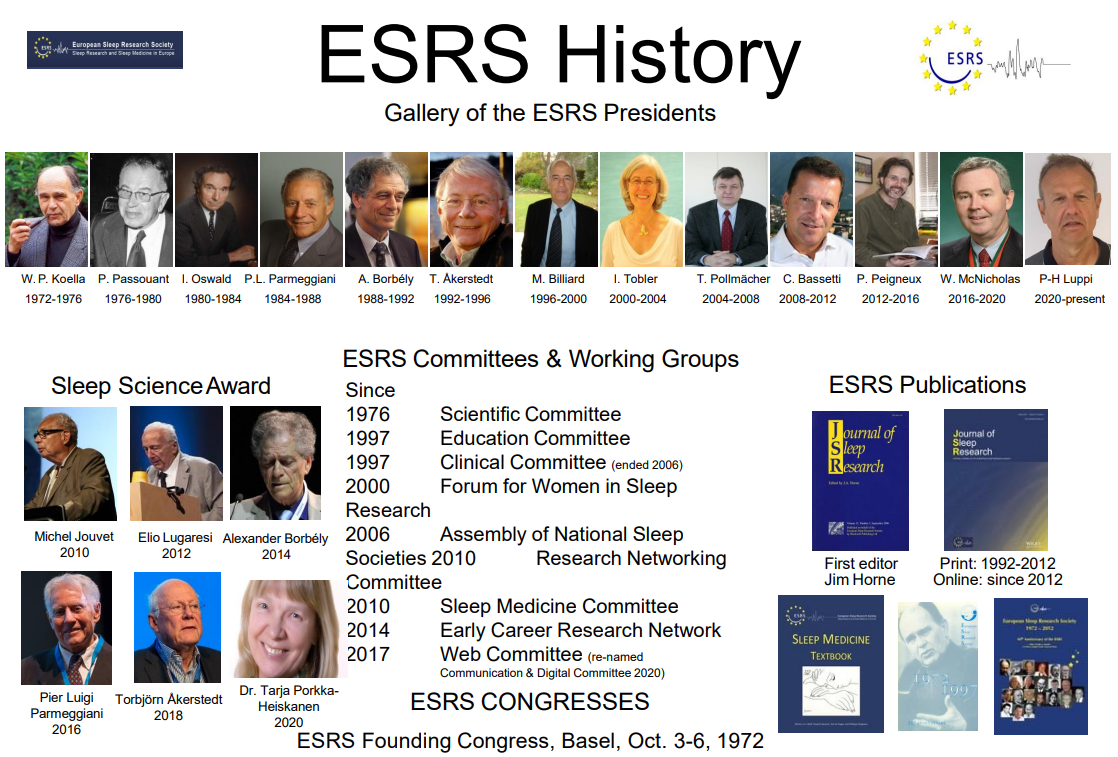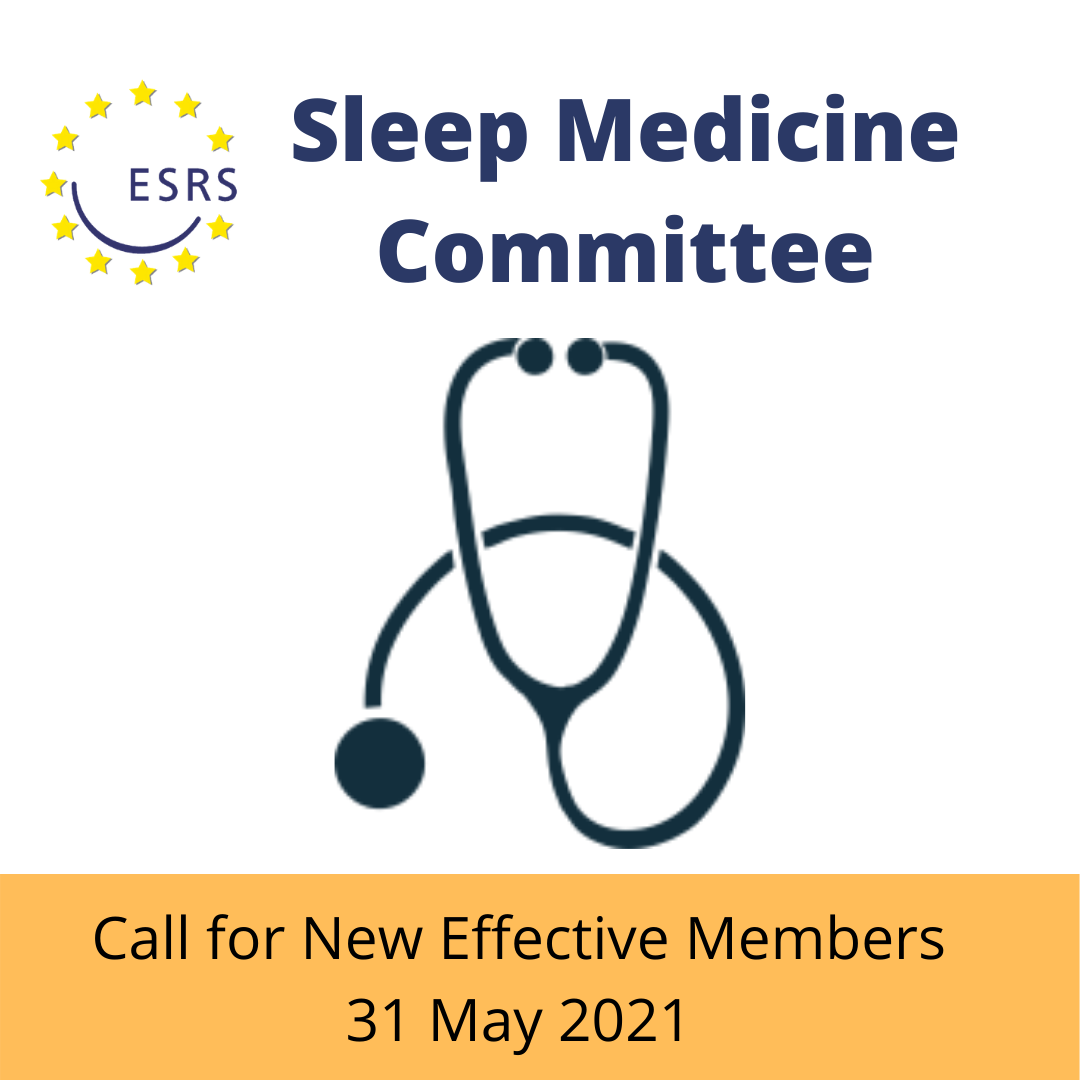ESRS call for candidates to become an effective member of the Sleep Medicine Committee for the management of a specific project.

The scope of project management / effective membership
Background
The purpose of the ESRS is to promote research on sleep and sleep-related areas, improve the care for patients with sleep disorders, and facilitate the dissemination of information regarding sleep research and sleep medicine. In accordance with the policy to appoint members to new positions, the ESRS launches a call for candidates to become effective members of the Sleep Medicine Committee.
The Sleep Medicine Committee (SMC) is a formal body of the ESRS. Its mission is to promote clinical sleep medicine as an integrated multidisciplinary field and as a healthcare discipline in its own right, accessible for healthcare providers from different professional backgrounds. The SMC creates added value for clinicians in several areas of interest, including credentialing, accreditation, creating didactic content, establishing a platform for guidelines, practice parameters and position papers. Paediatric sleep medicine is a special focus of interest.
Projects and effective members
To meet the objectives of the SMC, the listed areas of interest will be defined as distinct projects requiring appropriate management. For each of the foreseen projects an effective member will be appointed to the SMC. Effective members will act as project managers. Management comprises exploring, planning, implementation and follow-up. More information on project management can be found in the literature (for example on: https://opentextbc.ca/projectmanagement/).
Vacancies
Each of the following projects will be assigned to an effective member:
- Guidelines and other practice-related publications
- Paediatric sleep medicine
- Organisation / accreditation of sleep medicine practice
- Credentialing of sleep medicine professionals
- ESRS website content related to sleep medicine
The call for positions of effective membership will be launched on March 5, 2021. This function will be performed on a voluntary basis and shall not be compensated by a financial or a material benefit from the ESRS. The functions and tasks of these positions are described below (see: Specific projects). Applications via this form will be sent to the chair of the SMC [dirk.pevernagie@ugent.be] not later than May 31, 2021. Positions will be assigned by the ESRS Board to qualified candidates who submit the best proposal for managing a specific project. The mandate is assigned for a term of two years and can be renewed once for a second term.
The effective member must be committed and spend at least two to four hours a week on the project. She/he is entitled to propose the composition of the project group that will become operational following approval of the ESRS Board. Other commitments include:
- to manage the progress of the work
- to organize regular work meetings with the project group and to participate in the plenary SMC videoconferences that are held every two months
- to maintain contact with stakeholders
- to draft reports whenever necessary or appropriate
- to make a budget to be covered by the ESRS
- to ensure administrative assistance.
Specific projects
Project 1: Guidelines and other practice-related publications
To develop Guidelines and other practice-related publications is an important goal of the SMC. This project encompasses the creation of a platform for preparing new publications, the task of identifying suitable topics for publication, and the formation of task forces to draft manuscripts.
Key objectives:
- The effective member who manages this project is in charge of installing the project group, considering human, material and financial resources as well as operational requirements
- The scope of publications includes recommendations, guidelines, practice parameters and position papers
- The development of new publications should be carried out in coordination with the editor-in-chief of JSE and with the liaison members from EAN and ERS (when the publication of new papers is envisaged in the field of neurology and respiratory medicine, respectively).
- Conversely, publications on sleep initiated by EAN, ERS, or other parties collaborating with the ESRS, require active involvement of the effective member.
- Task forces for specific publications should be composed taking into account diversity, especially in terms of country representation, gender, age/career stage, multidisciplinary expertise, involvement of allied health care professionals.
- Timetables must be established for the different steps in the preparation of a manuscript.
- A budget should be calculated for necessary support by methodologists, librarians or other outsourced assistants. Also, travel and other costs should be calculated. These expenses will be covered by the ESRS following approval of the Board.
- While the most important task relates to supervision and coordination, the effective member may participate in writing manuscripts as a co-author.
- The effective member reports on the progress on a regular basis.
Requirements
The candidate:
- is a full member of the ESRS,
- has a visible track record in publishing guidelines,
- has experience with leading task forces,
- has access to support and logistics from her/his department or knows how to obtain such support elsewhere.
Project 2: Paediatric Sleep Medicine
To develop a network and communication platform for Paediatric Sleep Medicine is an important goal of the SMC. Such structure is paramount for gathering information on paediatric sleep centres and sleep specialists in different European countries. Collaboration with other paediatric scientific societies will be required, especially if the drafting of guidelines and other practice-related publications is envisaged. Also, research and teaching activities may be organized. The role of the ESRS should be pivotal in this context.
Key objectives:
- The effective member who manages this project is in charge of installing the project group, considering human, material and financial resources as well as operational requirements.
- An overview of paediatric sleep medicine in Europe should be made, locating the major stakeholders. The relationship of the ESRS with these other parties and the specific role of the ESRS in the constellation of scientific societies should be addressed. Opportunities for networking (with allocation of specific tasks to different parties) should be explored.
- The state of paediatric sleep medicine in different European countries should be mapped (in cooperation with the ANSS). Opportunities for supporting further development at the national level should be explored.
- Needs for accreditation of paediatric sleep centres and credentialing of professionals should be identified
- Also, an inventory of research and teaching opportunities should be made
- The initiative for new guidelines on paediatric sleep medicine should be made by this project group in collaboration with the guidelines project group. Also, the project group may participate in publications initiated by other parties
- The effective member reports on the progress on a regular basis.
Requirements
The candidate:
- is a full member of the ESRS,
- has a visible track record in paediatric sleep medicine,
- has experience with leadership,
- has access to support and logistics from her/his department or knows how to obtain such support elsewhere.
Project 3. Organisation / accreditation of sleep medicine practice
To monitor and to make recommendations on the Organisation and accreditation of sleep medicine practice is an important goal of the SMC. An ad hoc group of the ESRS has published the ‘European guidelines for the accreditation of Sleep Medicine Centres’ in 2006. This guideline has been instrumental for the organization of sleep healthcare in several European countries but is currently beyond its expiration date. Medical insights, technology and organisational structures have changed substantially over the years. Therefore, a new approach is needed. A new guideline (or practice parameters paper) should be prepared and published.
Key objectives:
- The effective member who manages this project is in charge of installing the project group, considering human, material and financial resources as well as operational requirements
- A new survey should be organised in collaboration with the ANSS to map the different types of organisational structures in the European countries. Contemporary sleep medicine is organised across different echelons: primary care, subspecialised centres, full-service sleep centres, but also networks that dynamically link the aforementioned levels of care. It will be worthwhile to investigate the present state of health care configurations in Europe
- From this survey, certain patterns may become evident that may serve as new models for delivering optimal personalized medicine.
- A new guideline / practice parameters paper should be written, based on the information above. Recent innovations should be clearly described in this manuscript.
- This exercise may be expanded to also drafting organizational requirements for teaching centres
- In addition, valuable information on official regulations and health insurance policies in the different countries may be retrieved.
- Recommendations for accreditation procedures should ensue. Ideally, a generic procedure may be devised that may be applied uniformly across different European countries
- A new point of interest is the accreditation of sleep medicine centres directly by the ESRS. What would be the rationale for such service? What is the point of view of the ANSS? What would be the scope of such European accreditation? Which logistic and financial implications should be considered?
- The effective member reports on the progress on a regular basis.
Requirements
The candidate:
- is a full member of the ESRS,
- has a visible track record in activities pertaining to quality control and/or organisational procedures,
- has experience with leadership,
- has access to support and logistics from her/his department or knows how to obtain such support elsewhere.
Project 4. Credentialing of sleep medicine professionals
The ESRS has fostered Credentialing of sleep medicine professionals for many years. The further development of this theme is an important goal of the SMC. Ad hoc groups of the ESRS have published the ‘European guidelines for the certification of professionals in sleep medicine’ in 2009 and the ‘Catalogue of knowledge and skills for sleep medicine’ in 2013. These papers have marked the contours of certified sleep medicine practice, but the materials need substantial revision. Professional standards, access to educational facilities and teaching institutions have changed considerably over the years. Also, special professional titles in sleep medicine have become available in many European countries. Therefore, an upgrade is mandatory, and a new guideline (or practice parameters paper) on this theme should be elaborated.
Key objectives:
- The effective member who manages this project is in charge of installing the project group, considering human, material and financial resources as well as operational requirements
- A new survey should be organised in collaboration with the ANSS to map the different types of credentialing in the European countries. As certification will depend on the professional backgrounds of the various healthcare providers, several educational domains and titles should be scrutinized. National programmes and educational systems should be assessed and compared.
- In clinical sleep medicine, the multidisciplinary integration of care is emphasized. Thus, multidisciplinary aspects of education and credentialing should also be considered.
- From this survey, certain patterns regarding education and credentialing may become evident. Such patterns may serve as new models for delivering optimal curricula and associated professional titles.
- A new guideline should be written, based on the information above. Recent innovations should be clearly described in this manuscript.
- This exercise may be expanded to also drafting educational standards for teaching centres
- Recommendations for credentialing procedures should ensue.
- A particular point of interest is the homologation of national teaching programmes by the ESRS. What would be the rationale for such service? What is the point of view of the ANSS? What would be the scope of developing a European homologation standard? Which logistic and financial implications should be considered?
- The effective member reports on the progress on a regular basis.
Requirements
The candidate:
- is a full member of the ESRS,
- has a visible track record in education and organisation of credentialing procedures,
- has experience with leadership,
- has access to support and logistics from her/his department or knows how to obtain such support elsewhere.
Project 5. ESRS website content related to sleep medicine
The dissemination of new content is an important goal of the SMC. The SMC has to provide specific information on sleep medicine for the ESRS website. Of course, this activity has to be carried out in close cooperation with the Digital and Communication Committee (DCC). The list of newsworthy items is huge. It is important to select and order the data to provide the interested readers with concise information. In addition, the website may provide information to supplement other sources (e.g. the Sleep Medicine Textbook, guidelines). Especially, the e-SLEEP section of the website can be complemented with didactic material from clinical practice (e.g. case reports)
Key objectives:
- The effective member who manages this project is in charge of installing the project group, considering human, material and financial resources as well as operational requirements
- The preparation and delivery of content must be carried out in close cooperation with the DCC. To that end, a member of the DCC should become a permanent member of this project group.
- The scope of website content includes reporting progress of the SMC, output produced by the SMC, news from (collaboration with) other societies, other news that may be suitable for publication on the SMC section or other sections of the website
- The section on e-SLEEP lessons is dedicated to education in clinical sleep medicine and requires a new development. A table of contents must be designed first. Subsequently, content can be added. The existing section on e-SLEEP BASIC can serve as an example.
- The effective member and her/his project group are to make an inventory of all the relevant tasks of this group. For comprehensive tasks, e.g. the creation of the e-SLEEP CLINICAL, external experts may be invited or consulted to deliver specific content.
- The effective member reports on the progress on a regular basis.
Requirements
The candidate:
- is a full member of the ESRS,
- has a visible track record in editing content and in organizing structured information,
- has demonstrable experience with e-learning platforms
- has experience with leadership,
- has access to support and logistics from her/his department or knows how to obtain such support elsewhere.



